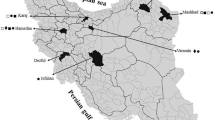Summary
Virulence of 12Fusarium oxysporum isolates was determined on three potato cultivars Late Harvest, BP1 and Kimberley Choice. The production of fusaric acid by the 12F. oxysporum isolates was also determined. The aim of the study was to determine whether a correlation exists between fusaric acid production and virulence ofF. oxysporum isolates. Late Harvest was the most tolerant and BP1 the most susceptible cultivar. Virulence ranking, order of theF. oxysporum isolates with the different cultivars corresponded with the mean of value of the ranking order for all three cultivars. A correlation was found between virulence of isolates and fusaric acid production except for Late Harvest. Fusaric acid production may play a major role in the development of dry rot in potato tubers.
Similar content being viewed by others
References
Branchard, M., 1984. Application des vitrométhodes à mise en oeuvre de programmes de sélection de plantes résistantes á des maladies.Agronomie 4: 905–911.
Brettell, R.I.S. & D.S. Ingram, 1979. Tissue culture in the production of novel disease-resistant crop plants.Biological Review 54: 329–345.
Daub, M.E., 1986. Tissue culture and the selection to pathogens.Annual Review of Phytopathology 24: 159–186.
Earle, E.D., 1978. Phytotoxin studies with plant cells and protoplasts In: T.A. Thorpe (Ed.), Frontiers of Plant tissue cultures, Proceedings of the 4th International Congress Plant tissue and Cell Culture, Calgary, pp. 363–372.
Galston, A.W., 1974. Molding new plants.Natural History 83: 94–96.
Gracen, V.E., M.J. Forster, K.D. Sayre & C.O. Grogan, 1971. Rapid method for selecting resistant plants for control of southern corn leaf blight.Plant Disease Reporter 55: 469–470.
Jullien, M., 1988. Effects of theFusarium sp. toxins and selections of crude toxin resistant strains in mesophyll cell cultures ofAsparagus officinales.Plant Physiology and Biochemistry 26(6): 713–721.
Mégnégneau, B. & M. Branchard, 1988. Toxicity of fusaric acid observed on callus cultures of variousCucumis melo genotypes.Plant Physiology and Biochemistry 26: 585–588.
Nelson, P.E., T.A. Toussoun & R.J. Cook, 1981. Fusarium: Diseases, Biology and Taxonomy. The Pennsylvania State University Press, University Park, Pennsylvania.
Pegg, G.F., 1981. Biochemistry and physiology of pathogenesis. In: M.E. Mace, A.A. Bell & C.H. Beckman (Eds), Fungal wilt diseases of plants. Academic Press, New York, pp. 193–246.
Steyn, P.J., M. McKenzie & A.F. Visser, 1991. Resistance in potato tubers to dry rot caused byFusarium solani.Journal of South African Horticultural Society 1: 19–21.
Theron, D.J. & G. Holz, 1989.Fusarium species associated with dry and stem-end rot of potatoes in South Africa.Phytophylactica 21: 175–181.
Toyoda, H., K. Katsuragi, T. Tamai & S. Ouchi, 1991. DNA sequence of genes for detoxification of fusaric acid, a wilt-inducing agent produced byFusarium species.Journal of Phytopathology 133: 265–277.
Venter, S.L., D.J. Theron, P.J. Steyn, D.I. Ferreira & A. Eicker, 1992. Relationship between vegetative compatibility and pathogenicity of isolates ofFusarium oxysporum f. sp.tuberosi from potato.Phytopathology 82: 858–862.
Wenzel, G., 1985. Stategies in unconventional breeding for disease resistance.Annual Review of Phytopathology 23: 149–172.
Yoder, O.C., 1980. Toxins in pathogenesis.Annual Review of Phytopathology 18: 103–129.
Yoder, O.C., 1983. Use of pathogen produced toxins in genetic engineering, of plants and pathogens. In: T. Kosuge, C.P. Meredith & H. Hollaender (Eds), Genetic engineering of plants. Plenum Press, New York, pp. 335–353.
Author information
Authors and Affiliations
Rights and permissions
About this article
Cite this article
Venter, S.L., Steyn, P.J. Correlation between fusaric acid production and virulence of isolates ofFusarium oxysporum that causes potato dry rot in South Africa. Potato Res 41, 289–294 (1998). https://doi.org/10.1007/BF02358198
Accepted:
Issue Date:
DOI: https://doi.org/10.1007/BF02358198




